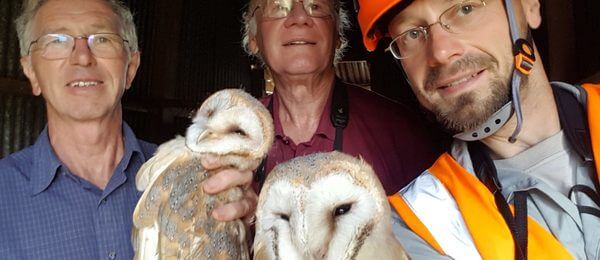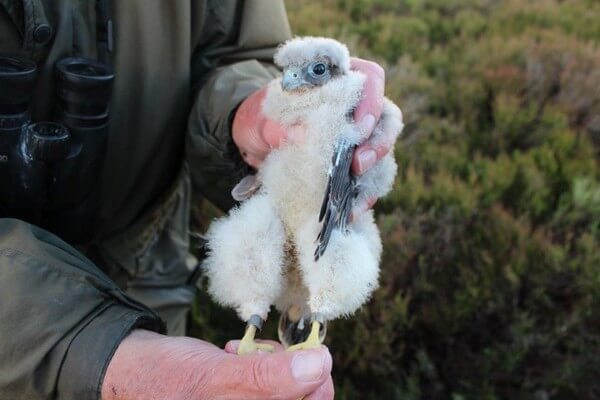News Release from windfair.net
Wind Industry Profile of
Wildlife in Harmony with Wind Energy
Actually, the artificial nesting boxes around Crystal Rig wind farm in Scotland were intended to provide a new home for long-eared owls. The boxes were hung as a bird protection measure, as the construction of the wind farm meant that some parts of the resident forest had to be cleared. When employees of the energy utility Natural Power checked the nesting boxes in the course of their bird surveillance, there was a surprise: Instead of the expected long-eared owls, barn owls brooded there, which had not existed in the area anymore.
Artificial nesting sites offer protection
Pawel Plonczkier, Environmental Consultant at Natural Power, explains: "The provision of artificial nest sites is a crucial part of any conservation initiative for barn owls, due to modern landscapes offering few nesting opportunities for this species. We subsequently monitored how many boxes were occupied and recorded the breeding success. Supporting the barn owls by provisioning artificial nest sites is vital not only for breeding birds but also for non-breeders and fledged youngsters that would use boxes for hiding and roosting – helping to increase their chance of survival."

The barn owls use the nesting places provided by Natural Power (Image: Natural Power)
First successes from the bird protection measures taken in the past years are also reported by Vattenfall. Last year, for example, some young merlins growing up in the area were ringed near the Ray wind farm in the north of England. This bird species has almost died out in Great Britain in recent years and is on the Red List. There are only about 1000 to 1500 pairs left in the UK.
Habitat is being renatured
Vattenfall now hopes that, in addition to broader ornithological monitoring in the vicinity of the wind farm, the trend towards successful breeding trials with merlins and other upland specialists such as curlews and golden plovers will continue.
As part of the habitat management plan, the company also worked on the highly sensitive bird habitats. Among other things, blanket bog was renaturalised by re-wetting the surrounding area. Aim is to increase the biodiversity of the local flora, which in turn will help to provide a habitat for more insects and beetles. As these serve as food sources for a number of birds, the entire local wildlife benefits.

One of the ringed merlins (Image: Vattenfall)
In the U.S., too, energy companies and environmentalists are focusing on cooperation. Last year, the American Wind Wildlife Institute (AWWI) celebrated its tenth anniversary. The organization was founded by the wind industry to maximize the protection opportunities that wind energy provides through collaboration and research. The Wind Wildlife Research Fund was established in 2018.
A fund for research
This fund primarily finances research projects dealing with the interaction between wildlife and wind energy. In addition, technologies and methods are being researched that can be used to minimize or eliminate the effects of wind power on wildlife. The initiative is financed by wind power companies, with further funds coming from nature conservation associations.
"This first-of-its-kind fund will make it possible to continue to expand wind energy development while also protecting and conserving wildlife populations," said Greg Wolf, CEO of Leeward Renewable Energy. "It speaks volumes about the wind industry’s values that so many companies have stepped up to invest in the fund."
Fewer dead bats
Some companies are also directly working on the subject of reducing negative impacts of wind turbines on nature and animals, e.g. NRG Systems having developed a system that lowers the effect of wind turbines on bats. During the two-year tests at the Los Vientos wind farm in Texas, the deadly collisions of some bat species were reduced by 54 percent.

With this system, bats are to be kept away from the turbines in the future (Image: NRG Systems)
The system works with ultrasonic signals. It is based on 'jamming' - the echo locating function that bats rely on for orientation, foraging and communication - without affecting the animals moving in the air around the turbines.
Sara Weaver, doctoral candidate at Texas State University, and biology lecturer at A&M, San Antonio, who led the Los Vientos study, emphasizes the success of the system that will be launched this year: "Our results from a robust, two-year study at an operational wind energy facility in Texas indicate NRG’s acoustic deterrents significantly reduce Brazilian free-tailed bat and hoary bat fatalities. Based on these results, the technology is a promising tool for reducing bat fatalities at wind turbines."
- Author:
- Katrin Radtke
- Email:
- press@windfair.net
- Keywords:
- wildlife, bird, bat, wind energy, wind turbine, protection, conservation, environmentalists, habitat



























